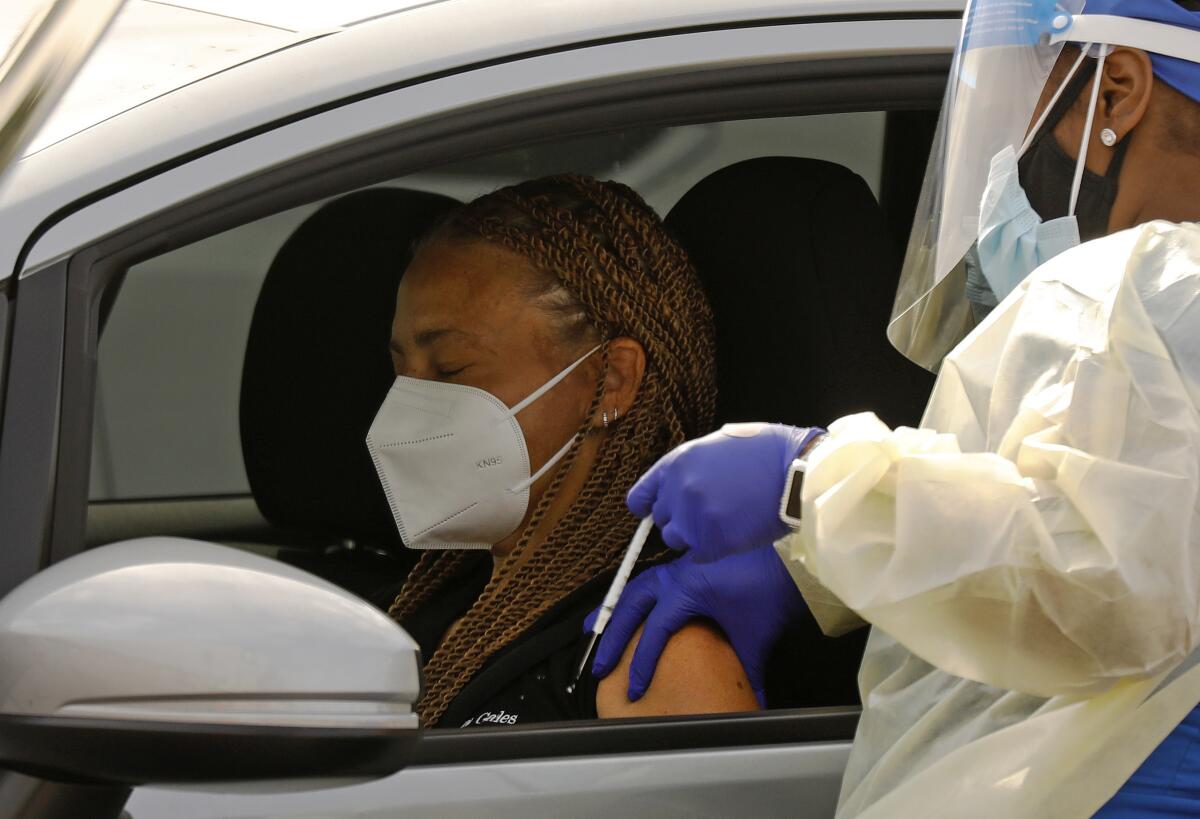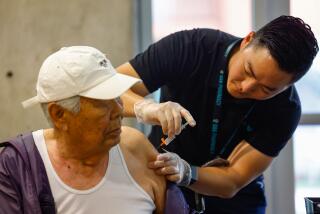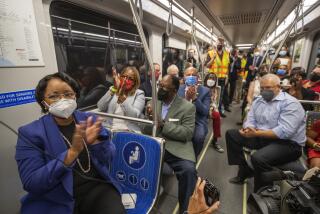We’re one horrible year into the pandemic. Is that hope we see on the horizon?

- Share via
Almost exactly one year ago, the following headline appeared in the Los Angeles Times:
“Coronavirus spreads to Los Angeles, Orange County: How concerned should we be?”
More than we knew, obviously.
I remember thinking, when the shutdown began last spring, that the days seemed to drag on and yet fade in a flash. A year later, after relentless waves of stress and grief, time is still warped.
But since the pandemic hit, we’ve racked up nearly 16,000 deaths in L.A. County, 3,000 in Orange County and almost 40,000 in the state. California has had more than 3.2 million confirmed cases of COVID-19 in that time and in December alone, 2,200 L.A. County healthcare workers tested positive for the virus.
So, how much longer will the nightmare last?
The short answer is that we don’t know. But with a small but steady trickle of vaccine, and the promise of much more, there’s finally some hope. And if you don’t believe me, let’s turn to an expert.
“I think that in the fall, we can really look forward to things being more normalized,” said Barbara Ferrer, director of the Los Angeles County Public Health Department.
OK, so it’s not like the fall is tomorrow, but at least we’ve got something to shoot for.
“I’m not sure everything will be exactly like it was, but I hope schools will be open, and universities and colleges will be open, and most businesses will be open,” Ferrer added, qualifying her remarks by saying we are likely to still need masking, distancing and other protective measures.
The next two months are critical, Ferrer added. And anybody who thinks we can begin to let our guard down better think again. Case numbers are still critically high, vaccine is in short supply, and new coronavirus variants pose new threats.
Emerging from the pandemic is going to take all of us — including our public officials, and I’m starting to wonder about some of them. Take Gov. Gavin Newsom, whose pandemic response sometimes makes you wonder if he’s consulting a Ouija board.
His latest move was lifting some lockdown requirements. The timing of that move seems crazy to me, given how little we know about new strains of the virus and whether existing vaccines can beat them back, and it’s hard to see his move as anything other than a political response to the fledgling recall movement against Newsom.
Ferrer thinks we should be very careful. “I’m all in favor of … getting our economy back,” she said, but she called this “a time for great caution.”
That means there will still be rules against public gatherings, with strict restrictions on outdoor dining, and, Ferrer said, citations for those who don’t comply. We all want struggling businesses to reopen, but if we rush that process everyone will pay.
When we spoke on Wednesday afternoon, Ferrer told me L.A. County had just recorded an additional 300 deaths from COVID-19 in the previous 24 hours. It was offered as a reminder of how grave the situation remains, and how much work is left to do.
Yes, a great deal more, on many fronts, and Ferrer conceded that. The county has to do a better job of finding ways to get vaccine to the hardest-hit groups, she said, to underserved communities of color, to front-line workers with greater risk and less access to vaccinations.
A 66-year-old who works 12-hour shifts at a grocery store needs the same access to vaccines as a 66-year-old who’s retired or works from home, Ferrer said. And she hopes that eventually, there will be enough vaccine so that homebound or disabled people will be vaccinated by their regular healthcare providers.
At the moment, if you’re a senior who doesn’t have access to a computer or transportation, getting a vaccine is next to impossible for most people.
I could fill the pages of this entire section with emails to me from seniors, or their adult offspring, who have gone mad trying to line up appointments in the various Southern California counties where they live.
“I feel like I’m a jockey at the gate, waiting for the gun to go off, with heart pounding, hands at the keyboard,” wrote retired teacher Linda Linville, who couldn’t get an appointment anywhere. “The first time I entered the race, I got so many error messages my head was spinning.”
And you may have seen the story by The Times’ Hayley Smith about seniors standing in line for hours, with no bathrooms and no guarantees, trying to score a shot of Pfizer or Moderna. The biggest problem is that there isn’t nearly enough vaccine available yet to inject all healthcare workers and everyone 65 and older, so it’s as if thousands are queueing up for a few lifeboats.
But that doesn’t explain or excuse all the bugs in finicky, inept county and state websites — as well as those of grocery store pharmacy chains — that have brought more chaos than order to the vaccine appointment process. Now I’m hearing from people who finally got an appointment at a Ralphs, only to be told the vaccine is being shipped to the county, so get in another line.
In the home state of Silicon Valley, how can it be that hard to set up a system that allows people to register for vaccinations and then sends them appointment times when the vaccine is available?
“Couldn’t they contract this website to some 15-year-old who knows what he’s doing?” asked 77-year-old novelist John Shannon, who lives in Brentwood and wrote to tell me about his frustrating time on the state vaccine appointment website.
“Like everything California does relating to computers, this website is as dumb as a box of hammers and as useful as a paper teapot.”
I couldn’t have said that better, nor this:
“Since it’s a reservation system, why can’t it take reservations?” Shannon asked.
And meanwhile, people just keep dying.
Stephanie Hall, chief medical officer of Keck Medicine of USC, said her medical staff sees a steady procession of people with survivor’s guilt.
“They’ll come and say, ‘I killed my mother, my father, my wife, because I wasn’t careful or disregarded it or didn’t take it seriously,’” said Hall, who hopes there has been enough loss by now for people to wake up to reality.
Unlike me, Hall said she suspected early in 2020 that the virus would deliver a brutal blow for an entire year.
But at the moment, she shares Ferrer’s cautiously optimistic take, agreeing that the next several weeks are critical for getting more vaccine into arms faster while maintaining all the necessary masking and distancing precautions.
“People are lining up, they want to be vaccinated, the health systems want the vaccine and we just need to get more delivered,” Hall said.
Hear, hear.
Fingers crossed.
More to Read
Sign up for Essential California
The most important California stories and recommendations in your inbox every morning.
You may occasionally receive promotional content from the Los Angeles Times.














